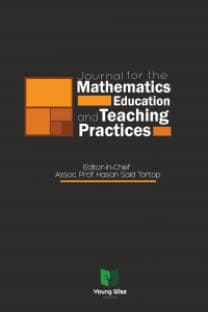Use of the Theory of Fischbein and the Theory of Shulman for the Study of Teachers’ Algorithmic Knowledge Concerning the Concept of the Altitude of a Triangle
Use of the Theory of Fischbein and the Theory of Shulman for the Study of Teachers’ Algorithmic Knowledge Concerning the Concept of the Altitude of a Triangle
algorithmic knowledge, Fischbein’s theory, Shulman’s theory, concept image, PCK, SMK altitude of a triangle.,
___
- Fischbein, E. (1994). The interaction between the formal, the algorithmic, and the intuitive components in a mathematical activity. In R. Biehler, R. W. Scholz, R. Straber, & B. Winkelmann (Eds.), Didactics of Mathematics as a Scientific Discipline (pp. 231-245). Dordrecht: Kluwer Academic.
- Fischbein, E., & Nachlieli, T. (1998). Concepts and figures in geometrical reasoning. International Journal of Science Education, 20(10), 1193-1211.
- Fujita, T., & Jones, K. (2007). Learners’ understanding of the definitions and hierarchical classification of quadrilaterals: Towards a theoretical framing. Research in Mathematics Education, 9(1), 3-20.
- Gal, H. (2011). From another perspective-training teachers to cope with problematic learning situations in geometry. Educational Studies in Mathematics, 78(2), 183-203.
- Gal, H. (1998). What do they really think? What students think about the median and bisector of an angle in the triangle, What they say and what their teachers know about it. In A. Olivier, & K. Newstead (Eds.), Proceedings of the 22nd International Conference for the Psychology of Mathematics Education, 2 (pp. 321-328). South Africa: Stellenbosch.
- Gal, H., & Vinner, S. (1997). Perpendicular lines - What is the problem? Pre-service teachers’ lack of knowledge on how to cope with students’ difficulties. In E. Pehkonen (Ed.), Proceedings of the 21st International Conference for the Psychology of Mathematics Education, 2 (pp. 281-288). Finland: Lahti.
- Gutierrez, A. & Jaime, A. (1999). Preservice primary teachers' understanding of the concept of altitude of a triangle. Journal of Mathematics Teacher Education, 2, 253-275.
- Hilf, N., & Abu Naja, M. (2019). Identification of altitudes in triangles and reponse times for identifying them among students of the sixth grade. Strong Number 2000, 30, 46-52.
- Hershkowitz, R. (1989a). Images of Geometric Concepts among Students and Teachers. Dissertation for receipt of Doctor of Philosophy (PhD) degree. Jerusalem: The Hebrew University of Jerusalem.
- Hershkowitz, R. (1989b). Visualization in geometry - Two sides of the coin. Focus on Learning Problems in Mathematics, 11, 61-76.
- Hershkowitz, R. (1987). The acquisition of concepts and misconceptions in basic geometry- Or when 'A little learning is dangerous thing'. In J. D. Novak (Ed.), Proceedings of the Second International Seminar Misconceptions Educational Strategies in Science and Mathematics, 3 (pp. 238-251). NY, Ithaca: Cornell University.
- Linchevsky, L. (1985). The Meaning Elementary School Teachers Attribute to the Terms Used by Them in Teaching Arithmetic and Geometry. Dissertation for receipt of Doctor of Philosophy (PhD) degree. Jerusalem: The Hebrew University of Jerusalem.
- NCTM - National Council of Teachers of Mathematics. (2000). Principles and Standards for School Mathematics. Reston, VA: National Council of Teachers of Mathematics.
- The Ministry of Education and Culture. (2014). The new curricula in mathematics for grades 7, 8, and 9. available at http://cms.education.gov.il/EducationCMS/Units/Mazkirut_Pedagogit/Matematika/ChativatBeinayim/
- Shulman, L. S. (1986). Those who understand: Knowledge growth in teaching. Educational Researcher, 15(2), 4-14.
- Tall, D., & Vinner, S. (1981). Concept image and concept definition in mathematics with particular reference to limits and continuity. Educational Studies in Mathematics, 12, 151-169.
- Tsamir, P., & Tirosh, D. (2008). Combining theories in research in mathematics teacher education. ZDM, 40, 861-872.
- Vinner, S. (1991). The role of definitions in teaching and learning of mathematics. In D. Tall (Ed.), Advanced Mathematical Thinking (pp. 65-81). Dordrecht: Kluwer.
- Vinner, S., & Hershkowitz, R. (1983). On concept formation in geometry. ZDM, 15, 20-25.
- Yayın Aralığı: Yılda 2 Sayı
- Başlangıç: 2020
- Yayıncı: Genç Bilge Yayıncılık
Mathematics textbooks content development at the primary stage: a proposed vision
Ibrahim KHALİL, Mohamed ALNATHEER
The effect of the collaborative learning technique on students ’educational performance in math
Large scale Open Educational Resources (OER) initiative in mathematics
